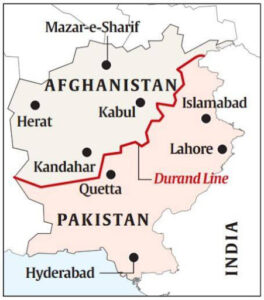In news– Recently, Taliban spokesman Zabiullah Mujahid said that Afghans oppose the fence erected by Pakistan along the Durand Line.
About the Durand Line
- The Durand Line is the 2,670-kilometre international land border between Afghanistan and Pakistan.
- The Durand Line is a legacy of the 19th century Great Game between the Russian and British empires in which Afghanistan was used as a buffer by the British against a feared Russian expansionism to its east.
- The agreement known as the Durand Line was signed on November 12, 1893 between the British civil servant Sir Henry Mortimer Durand and Amir Abdur Rahman, then the Afghan ruler.
- Abdur Rahman became king in 1880, two years after the end of the Second Afghan War in which the British took control of several areas that were part of the Afghan kingdom.
- His agreement with Durand demarcated the limits of his and British India’s spheres of influence on the Afghan frontier with India.

- The line stretches from the border with China to Afghanistan’s border with Iran.
- The Clause 4 of the agreement said ‘ the “frontier line” would be laid down in detail and demarcated by British and Afghan commissioners who arrive by mutual understanding at a boundary which shall adhere with the greatest possible exactness to the line shown in the map attached to this agreement, having due regard to the existing local rights of villages adjoining the frontier’.
Dividing the Pashtun tribal areas
- In reality, the line cut through Pashtun tribal areas, leaving villages, families, and land divided between the two spheres of influence.
- It has been described as a “line of hatred”, arbitrary, illogical, cruel and a trickery on the Pashtuns.
- Some historians believe it was a ploy to divide the Pashtuns so that the British could keep control over them easily.
- The line also put on the British side the strategic Khyber Pass.
Durand line: the point of cross-border tensions
- After independence in 1947, Pakistan inherited the Durand Line, and with it also the Pashtun rejection of the line, and Afghanistan’s refusal to recognise it.
- ‘Pashtunistan’, an independent country of the Pashtuns was a demand made by Khan Abdul Ghaffar Khan at the time of Partition, although he later resigned himself to the reality of Partition.
- The proximity of the ‘Frontier Gandhi’ to India was a point of tension between the two countries almost immediately.
- Pakistan’s creation and support for the Taliban is seen by some as a move to obliterate ethnic Pashtun nationalism with an Islamic identity.
- When the Taliban seized power in Kabul the first time, they rejected the Durand Line.
- They also strengthened Pashtun identity with an Islamic radicalism to produce the Tehreek-e-Taliban Pakistan.
- As cross-border tensions peaked in 2017 with several attacks on Pakistani border posts by militants and Pakistan began erecting a fence on the Durand Line.
- Now mostly completed, the fence has been a source of more tensions as Afghans, and Pashtuns on both sides of the border, see it as a move by Pakistan to formalise the boundary, making their division permanent.
















